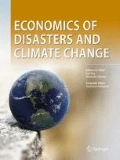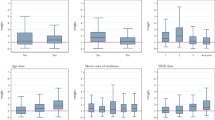Abstract
This paper provides a new angle on the question of crowding effects of public policies. We examine how non-hypothetical self-insurance behavior by households responds to variations in public investments in relief capabilities based on a large disaster preparedness survey (n = 19,071) conducted in Japan in 2012. In our specific setting which looks at emergency drinking water, (i) government provides in-kind, rather than cash, relief and (ii) the crowding effect observed is more apt to be total, rather than partial. In contrast to much of the literature studying crowding effects of cash relief, we find little evidence for crowding out in emergency drinking water, with an upper bound of 2% at the intensive margin. We also identify important benefits of targeting in-kind relief to households with minors.
Similar content being viewed by others
Notes
In developed countries, the contribution of EDW to morbidity and mortality reduction mainly relates to water safety rather than water availability. In a post-disaster environment, disruption of access to uncontaminated drinking water ranks as a primary concern since populations quickly become vulnerable to water-borne diseases.
When capital markets are incomplete and households are liquidity constrained, cash relief could arguable induce crowding effects simply by allowing households to monetize illiquid assets.
Conceptually, self-insurance is the most appropriate definition for behavior in which households store EDW in their own home.
Self-protection could – theoretically – take the shape of activities such as sinking private wells or purchasing water filtration equipment. Such measures are typically either not available (wells) or not cost-effective (water filtration).
This is, in fact, not unusual: Also in countries such as the US, officials are typically vaguely aware of the true level of disaster preparedness in the population, and regional or local variations within these levels (Donahue 2010). Donahue et al. (2013) also find that there are fundamental differences between officials’ perceptions of citizens’ preparedness and citizens’ perception of own preparedness.
One English-language example is provided here: http://www.city.hyuga.miyazaki.jp/display.php?cont=160418152455 (accessed on March 10, 2017)
The survey asked households also about other dimensions of preparedness, e.g. emergency food, which is recommended by the authorities. In contrast to water, idiosyncratic tastes matter for food choice and render the identification less clean.
Public assistant often come with financial assistance as relaxation of loan terms where private assistant is more on in-kind relief and donation as cash. This is similar to recent disaster of 2016 Kumamoto Earthquake.
For a HH member of 13 years of age or older, the amount is 6 l. For the age group between 8 and 12 years, the supply is set at 4.5 l and at 3 l for ages below 8 years. Given the age composition of a HH, there is a specific recommended level of EDWS (in liters) composed of the sum of individual EDW needs. So a family with two adults, child aged 10 and another aged 6 would have to maintain a total supply of 19.5 l EDW in storage continuously in order to comply with the recommendations.
This is in line with previous papers that have noted the relatively rapid decline in the impact of disaster experience on preparedness (Botzen et al. 2009; Kunreuther et al. 1985). Note that we do not control for the age of the head of the household, which could be expected to mitigate the decline in preparedness (Osberghaus 2015).
There may be a small role for insurance through neighbors and other social networks. However, disaster entail highly correlated risk events that render risk sharing ineffective.
References
Asseldonk M, Meuwissen M, Huirne R (2002) Belief in disaster relief and the demand for public-private insurance program. Rev Agric Econ 24(1):196–207
Botzen WJW, van den Bergh JC (2012a) Risk attitudes to low-probability climate change risks: WTP for flood insurance. J Econ Behav Organ 82(1):151–166
Botzen WJW, van den Bergh JC (2012b) Monetary valuation of insurance against flood risk under climate change. Int Econ Rev 53(3):1005–1026
Botzen WJW, Aerts JCJH, van den Bergh JC (2009) Willingness of homeowners to mitigate climate risk through insurance. Ecol Econ 68(8):2265–2277
Browne MJ, Hoyt RE (2000) The demand for flood insurance: empirical evidence. J Risk Uncertain 20(3):291–306
Brunette M, Cabantous L, Couture S, Stenger A (2013) The impact of governmental assistance on insurance demand under ambiguity: a theoretical model and an experimental test. Theor Decis 75(2):153–174
Buchanan JM (1975) The Samaritan's dilemma. In: Phelps ES (ed) Altruism, morality and economic theory. Russel Sage Foundation, New York, pp 71–85
Cohen C, Werker ED (2008) The political economy of “natural” disasters. J Confl Resolut 52(6):795–819
Connolly MA, Gayer M, Ryan MJ, Salama P, Spiegel P, Heymann DL (2004) Communicable diseases in complex emergencies: impact and challenges. Lancet 364(9449):1974–1983
Donahue AK (2010) Household risk perception, preferences, and preparedness survey findings. Retrieved from http://www.dpp.uconn.edu/faculty/bios/a_donahue.html
Donahue AK, Fitzpatrick C (2010) Household risk perception, preferences, and preparedness. University of Connecticut DIEM: A DHS Center of Excellence, UConn Department of Public Policy Disaster Risk Perception, Preferences, and Preparedness Project
Donahue AK, Eckel CC, Wilson RK (2013) Ready or not? How citizens and public officials perceive risk and preparedness. Am Rev Public Admin 44(4_suppl):89S–111S
Ehrlich I, Becker G (1972) Market insurance, self-protection and self-insurance. J Polit Econ 80:623–648
Government of Japan (GoJ) (2012), National progress report on the implementation of the Hyogo framework for action (2011-2013), Cabinet office, Oct 18, 2012
Kahn ME (2005) The death toll from natural disasters: the role of income, geography, and institutions. Rev Econ Stat 87(2):271–284
Kanemoto Y (1997) The housing question in Japan. Reg Sci Urban Econ 27(6):613–641
Keirstead J, Shah N. (2012). Urban energy systems planning, design and implementation. In: A Grubler and D. Fisk (eds.): Energizing sustainable cities: assessing urban energy, chapter 11, 155–162
Koerth J, Vafeidis AT, Hinkel J, Sterr H (2013) What motivates coastal households to adapt pro-actively to sea-level rise and increasing flood risk? Reg Environ Chang 13(4):897–909
Kousky C, Shabman L (2013) The hazard of the moral hazard-or not. Natural Hazards Observer XXXVII(5):12–15
Kousky C, Michel-Kerjan EO, Raschky PA (2018) Does federal disaster assistance crowd out flood insurance?. J Environ Econ Manag 87:150–164
Kunreuther H (1996) Mitigating disaster losses through insurance. J Risk Uncertain 12:171–187
Kunreuther HC (2006) Has the time come for a comprehensive natural disaster insurance?. In: Daniels RJ, Kettl DF, Kunreuther HC (eds) On risk and disaster: lessons from Hurricane Katrina. University of Pennsylvania Press, Pennsylvania, pp 175–202
Kunreuther H, Sanderson W, Vetschera R (1985) A behavioral model of the adoption of protective activities. J Econ Behav Organ 6(1):1–15
Lewis T, Nickerson, D (1989) Self-insurance against natural disasters. J Environ Econ Manag 16(3):209–223
Managi S, Guan D (2017) Multiple disasters management: lessons from the Fukushima triple events. Econ Anal Policy 53:114–122
Munro A, Managi S (2017) Going back: radiation and intentions to return amongst households evacuated after the great Tohoku earthquake. Econ Disasters Clim Chang 1(1):77–93
Nakayachi K, Okuyama HM, Oki S (2015) Public anxiety after the 2011 Tohoku earthquake : fluctuation in hazard perception after catastrophe. J Risk Res 18(2):156–169
Neumayer E, Plümper T, Barthel F (2014) The political economy of natural disaster damage. Glob Environ Chang 24:8–19
Osberghaus D (2015) The determinants of private flood mitigation measures in Germany—evidence from a nationwide survey. Ecol Econ 110:36–50
Petrolia DR, Landry CE, Coble KH (2013) Risk preferences, risk perceptions, and flood insurance. Land Econ 89(2):227–245
Quiggin, J. (1992). Risk, self-protection and ex ante economic value-some positive results. J Environ Econ Manag 23(1):40-53
Raschky PA, Schwindt M (2016) Aid, natural disasters and the Samaritan's dilemma. Economica 83(332):624–645
Raschky PA, Weck-Hannemann H (2008) Charity hazard – a real hazard to natural disaster insurance? Environ Hazard 7(4):321–329
Raschky PA, Schwarze R, Schwindt M, Zahn F (2013) Uncertainty of governmental relief and the crowding out of flood insurance. Environ Resour Econ 54:179–200
Shogren JF, Crocker TD (1999) Risk and its consequences. J Environ Econ Manag 37(1):44–51
Tanaka H, Oda J, Iwai A, Kuwagata Y, Matsuoka T, Takaoka M, Yoshioka T (1999) Morbidity and mortality of hospitalized patients after the 1995 Hanshin-Awaji earthquake. Am J Emerg Med 17(2):186–191
Turner G, Said F, Afzal U (2014) Microinsurance demand after a rare flood event: evidence from a field experiment in Pakistan. Geneva Pap 39:201–223
Watson JT, Gayer M, Connolly MA (2007) Epidemics after natural disasters. Emerg Infect Dis 13(1):1
Zehaie F (2009) The timing and strategic role of self-protection. Environ Resour Econ 44(3):337–350
Acknowledgements
Valuable comments on previous drafts of this paper have been provided by Christian Almer, Richard Butler, Luisa Dressler, Malte Lech, Paul Raschky, and Paul Schaudt as well as conference and seminar audiences at the 2016 EAERE conference, the Workshop on the Geospatial Analysis of Disasters and the CEAR/MRIC Behavorial Insurance Workshop 2016. We are grateful to Hiroki Onuma and Shinya Horie for research assistance. T. Goeschl’s research has been supported by a travel grant from the HeKKSaGOn network. S. Managi’s research has been supported by a Grant-in-Aid for Specially Promoted Research (26000001) by the Japanese Society for the Promotion of Science.
Author information
Authors and Affiliations
Corresponding author
Electronic supplementary material
ESM 1
(DOCX 40 kb)
Rights and permissions
About this article
Cite this article
Goeschl, T., Managi, S. Public in-Kind Relief and Private Self-Insurance. EconDisCliCha 3, 3–21 (2019). https://doi.org/10.1007/s41885-018-0031-8
Received:
Accepted:
Published:
Issue Date:
DOI: https://doi.org/10.1007/s41885-018-0031-8




